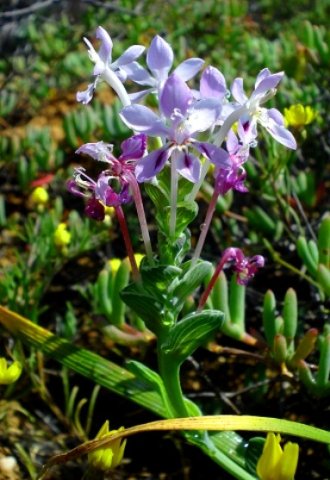Lapeirousia pyramidalis subsp. pyramidalis

Author: Ivan Lätti
Photographer: Judd Kirkel Welwitch
Lapeirousia pyramidalis has two notable subspecies: The pale flowers of L. pyramidalis subsp. pyramidalis differ from those of L. pyramidalis subsp. regalis in being white, cream, blue, pink or lilac rather than the dark purple of the latter subspecies. The plants are short cormous perennials, from 5 cm to 10 cm tall.
The lower three tepals of the two-lipped flowers have contrasting colour markings differentiating between the subspecies: On the paler subsp. pyramidalis flowers these markings are dark (often purple if they are present), with fuzzy margins and positioned on the central axis of the tepals. On the darker tepals of subsp. regalis the markings are white with sharply contrasting margins, positioned at the tepal margins.
The long leaf at the base of the plant in picture contrasts against the short, rounded and folded floral bracts up the flower stalk. The leaf is narrow with a ribbed surface.
This plant grows in the southwest of the Northern Cape, from central Namaqualand to the Western Cape, mainly through the Tankwa Karoo, the Little Karoo and the Overberg.
The habitat is fynbos and renosterveld in sandstone and shale soils. The habitat population of the subspecies is deemed of least concern early in the twenty first century.
Several of the Lapeirousia species of South Africa are commonly called cabong, the name that Khoi and or San tribes of South Africa's early history named these plants. The bell-shaped corms featured in the diets of (at least some of) those hunter-gatherer tribes.
Food and medicine plants tend to be named by human society, as do all environmental features that impact upon the lives of people. Today all living things merit names and study, as humanity has become aware of biological diversity itself. All the living species on earth are important to each other in the mutual interdependence of species for their continued existence, interactively and collectively.
Although people do not value weeds or vermin, we are inextricably part of one interlinked ecology. Our many, and some yet unknown service providers of known, unknown and unnoticed benefits live around us, close to us and numerous micro-organisms inside us. They don't do charity, all try to live as well as they can, just like us. They may have some needs serviced in turn by us we don't even know about. Why else would they bother? They also have links with yet other creepy or crawly things we do not value or see the need for. Things that should therefore not be exterminated simply because we have dislikes (Vlok and Schutte-Vlok, 2015; Manning, 2007; www.pacificbulbsociety.org; http://redlist.sanbi.org).

